Top 10 Horror Comics
By Desmond Reddick
31 October 2008 — Horror comics don't work. The pacing is too controlled, and the reader will never feel the danger. All horror books end up being superhero books with monsters. Well, that's what some people in the industry say. Those people are full of shit.
In fact, horror comics are some of the best I've ever read. There is a lot of crap out there, sure, but when there's a good horror comic, it does a few things right; like any good horror story, it makes you care about the characters, it forces you into a false sense of security, it builds suspense and it pulls the carpet out from under you at its climax.
I expect some of my inclusions (and many exclusions) will draw some ire, but I have compiled this list using three categories: quality, influence and what it did for me.
Some of them will be complete runs, others will be selections from those runs and sometimes it just might be a single story. So let's look at my all-time favorite horror comics.
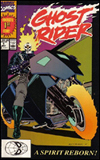 10. Ghost Rider, volume three
10. Ghost Rider, volume three
It certainly wasn't the best horror comic ever, and there are those who would say it is more of a superhero book than a horror book, but I was 10 years old when it debuted and in its first two years Ghost Rider tussled with Mephisto, zombie ninjas, a vampire, Mr. Hyde, Zodiak, Scarecrow, a cannibalistic preacher and a suicidal guy whose bargain with the devil gave him the fortitude to go through with the dirty deed and the powers that made it impossible to do so.
Combine all that with some solid writing by Howard Mackie and great art by Javier Saltares and his successor Mark Texeira (who did the finest work of his career on this book) and you have a winner — cheesy spikes and chains or not.
Those who think that Jason Aaron is currently doing wild things on Ghost Rider need only look back at the early part of this run to see he's only doing what's called for. As a prime example of ongoing horror comics not working, this series soon went into the gutter and suffered through several attempted resurgences before finding the shaky footing it's on now.
The horrifying themes and imagery run through my mind to this day. It wasn't great by any means, but it is a book I will never forget.
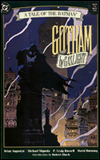 09. Batman: Gotham by Gaslight
09. Batman: Gotham by Gaslight
It sounds stupid: Batman versus Jack the Ripper. But Brian Augustyn crafts a story so fraught with tension and terror set amidst 1880s London. Though dripping with reality, the book introduces Batman, Commissioner Gordon, Harvey Dent and Joker to the seedy underbelly of 19th century London. In it, Bruce Wayne must stop the legendary killer, or face the blame himself.
If that's not enough for you, the marriage of Mike Mignola's pencils and P. Craig Russell's inks solidifies this book as nothing less than a masterpiece.
This comic was so smart it spawned the entire Elseworlds line, which, in turn, spawned some of the best DC Comics stories of the past 20 years.
But for a child fascinated with Gothic literature and comic books, this was the book that made me decide to make mine DC.
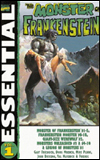 08. The Monster of Frankenstein / The Frankenstein Monster
08. The Monster of Frankenstein / The Frankenstein Monster
I've made no secret of my love for a certain novel written by a teenaged girl whose film adaptation would go on to influence so many lives. Yes, The Outsiders is such a glorious work that... oh, wait. We all know what I'm talking about here.
With an early 1970s loosening of the Comics Code Authority, Marvel's horror books were given more leeway as long as they stayed true to the tradition of their literary heritage. Thus Werewolf by Night became a superhero book — and a bad one at that. But, The Monster of Frankenstein (later titled The Frankenstein Monster) and Tomb of Dracula sprung from this loosening and we should all be grateful for it.
Gary Friedrich and Mike Ploog began with an adaptation / sequel of Mary Shelley's classic novel that spun into a great century-spanning adventure story. Doug Moench, Val Mayerik, Bernie Wrightson, John Buscema, Bill Mantlo and many other working class comic legends would add their touch to this beautiful, endearing and somewhat uneven series.
Sporting a bearskin coat obviously cribbed from the Universal film Son of Frankenstein, Marvel's version of the monster would go on to battle Dracula, cavemen, pitchfork-waving villagers, robots, ogres, monsters of all kinds and the descendants of his creator.
It was this book that pushed me to understand what an adaptation can do. Where I saw all of the film incarnations as inferior to the novel, this comic combined the aesthetic of those films with the spirit and weight of the original novel.
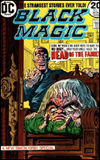 07. Black Magic
07. Black Magic
Flea markets can be wondrous things. I was a teenage Kirby fan when I stumbled across the first few issues of a DC series called Black Magic. They cost me a delightful $0.25 each and featured stories by Joe Simon and Jack Kirby. That's right, the squeaky Jewish-American boys who created Captain America did plenty of stories about surgery gone awry and freaks in the basement.
DC published reprints of the early 1950s Prize Comics series Black Magic starting in 1973, highlighting the tense and dramatic supernatural tales from the creators of the romance genre of comics. And they are awesome! They are particularly grotesque EC-style comics with each issue containing three or four stories and a one-page prose piece.
You see, while I absolutely love anthologies, they are an uneven product at best. I love Creepy Magazine, Vault of Horror and House of Mystery, but every issue of those books paired something great with something subpar. It's the nature of the beast. But imagine if you could take a bunch of Alex Toth's or Neal Adams' work from Creepy and publish it in sequential issues. That's what Black Magic is to me.
The stories may not be perfect, but the creative team is always the same and that is the guarantee you have going in. Simon and Kirby had a flair for horror stories, and worked newer, more innovative storytelling techniques into their tales. Even reading them today, I can appreciate that many of the twists go places I wouldn't expect them to.
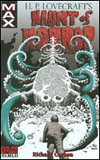 06. Richard Corben's Haunt of Horror
06. Richard Corben's Haunt of Horror
What is it about Richard Corben that I love so much? To be honest, I can't put my finger on it. His grasp of the grotesque? His storytelling? His wild but grounded anatomy? Maybe all of the above. What Corben does with his facial expressions and use of dark spaces makes it dangerous to turn the page. Whether he is drawing a creature with dripping fangs or a man screaming as he runs from an unknown terror, Corben creates some of the most suspenseful and terrifying comics out there.
I labored over what to choose for his entry on this list, and I chose his current labor of love for two reasons: it's very accessible with a wide appeal, and to shine a spotlight on his craftsmanship. His adaptations of the works of Poe and Lovecraft are the best comic book adaptations of those writers ever.
His sensibilities in the liberal adaptations of poems and short stories are examples of beautiful pieces of comic book storytelling and do great justice to the legendary authors. While I never want to see lesser examples of this from Corben, I certainly hope he continues the series by adapting other classic horror / suspense authors, such as Nathaniel Hawthorne, Ambrose Bierce, MR James or even Ray Bradbury and Harlan Ellison.
Whoever he chooses next, Corben's work on Haunt of Horror has already set a high watermarks for horror comics and should be viewed as such.
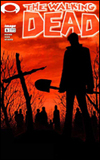 05. The Walking Dead
05. The Walking Dead
This series is the first survival horror book to work in an ongoing fashion. From the first issue, the book continues to get better and better. Robert Kirkman's ability to craft characters you fully identify with and feel for only to have them killed before your eyes is heartbreaking and awe-inspiring. What's even better is his ability to create characters you shouldn't like and slowly allow them to get inside your head.
Take a look at any good zombie movie and you'll notice that it isn't about the zombies. The dead are a backdrop for human drama, and there are few greater examples than this comic. It will truly make you wonder who the book refers to in its title.
While artist Tony Moore got the series running, it's Charlie Adlard who has grown the characters over the past five years. He makes a character losing their hand or holding their baby for the first time both equally believable in their impact. It also proves that a black and white comic can not only sell, but sell well.
Kirkman wanted to make his ongoing zombie movie, and this is better than almost every zombie movie I've ever seen. The status quo is shaken every few issues, and there are absolutely no guarantees — and that is why I love it. At the beginning of this article I mocked those who say horror comics don't work. Well, this is a shining example as to why they do.
As recent issues have pointed out, no one is safe. Not even the reader.
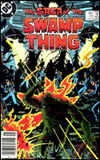 04. Alan Moore's Swamp Thing
04. Alan Moore's Swamp Thing
Alan Moore has made a career out of stripping characters down and redefining them. Miracleman, Joker, Superman, WildCATs, Captain Britain, Supreme and even characters from classic fiction (RE: League of Extraordinary Gentlemen and Lost Girls). But the first time he did it in America will always be the most memorable.
Saga of the Swamp Thing #20 began a run that would not only redefine a character, it would help define a universe. Swamp Thing was not a Vertigo book. In fact, Vertigo did not exist until six years after Moore's run ended. But it was Moore's work on Swamp Thing that led to DC embracing "mature" comic books, a career-defining editorial run by Karen Berger, the creation of the Vertigo line and its most enduring and arguably most popular character, John Constantine. Put it this way: Swamp Thing was a DCU book, but its collected editions were Vertigo books.
Beyond that, the stories wove fantasy and horror into human elements that everyone can relate to — like the best fantasy and horror stories do. Menstruation, the philosophical nature of death, ecological concerns, werewolves, swamp vampires and murderous demons taking the form of nightmares were all woven together into a comic that feels both like high literature and classic horror comics at the same time.
Add the lush and exceptionally inventive art by Stephen R. Bissette and John Totleben and this book becomes a classic horror comic book. It was a great book before Moore came along but after he left it would never be the same.
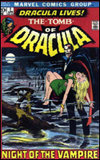 03. Tomb of Dracula
03. Tomb of Dracula
I was introduced to this series through the terrible animated TV movie some quarter decade ago and soon began diving through back issue. It must have been the quality of the series that made me forget this fact up until a mere few years ago. Well, youthful indiscretion has made my childhood memory hazy at best, but that's neither here nor there.
Tomb of Dracula is the greatest horror comic series in the history of horror comics. Hands down, bar none, close up shop. But for such a good series, the first six issues were unstable with everyone from Gardner Fox to Archie Goodwin taking shots at the story. On issue seven, a young Marv Wolfman began his (here it comes again) career-defining run. Wolfman was a bit of a wunderkind (though I hate the term), rising to Editor-in-Chief of Marvel at the age of 28. But Wolfman would always be known for his legendary runs on Tomb and Teen Titans, plus Crisis on Infinite Earths.
It was artist Gene Colan's painted-pencil style that really defined this book. Colan was a versatile and talented artist who started at the tail end of the Golden Age. He would pencil all 70 issues, plus a slew of stories in the follow-up magazine.
Being someone who never really liked vampire stories or movies, I just clicked with this story for some reason. The appeal of a villain as the lead in a story where we follow a group of people trying to kill him was just so cool to me. As rooted in the 1970s as this book is, it still stands up. I had collected roughly 40 mottled, creased issues of Tomb of Dracula before selling them to pick up the newly printed Essential volumes to get the whole story.
It was sweeping, dramatic and innovative, as well as modern and Gothic. I urge you all to check these stories out. They are some of the best Marvel has ever published.
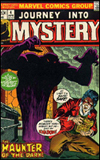 02. Journey into Mystery, volume two #4
02. Journey into Mystery, volume two #4
Didn't think I'd get this specific, did you? Running for 19 issues from 1972-75, the second volume of Journey into Mystery was another Marvel cash-in on the loosened reins of the CCA. The first five issues contained comic adaptations of classic horror short stories by some of the best comic creators in the business. It sold poorly and began reprinting the first volume along with early Tales to Astonish and Amazing Adult Fantasy with issue six.
The first five issues (another flea market grab) would introduce me to the writings of Robert Bloch and Robert E. Howard along with containing original stories by some of the best comic book talent of the time. But in the fourth issue, I was introduced to HP Lovecraft and Gene Colan in one fell swoop. Ron Goulart masterfully adapted Lovecraft's "Haunter in the Dark," and by "masterfully adapted," I mean he stepped back and let Gene Colan do his thing.
It probably wasn't the first time I'd seen Colan's artwork, as I'm sure I'd read Tomb of Dracula before this, but it was the first time I was aware I was seeing Colan's artwork. It was the perfect book to do so: Gothic cathedrals, Edwardian architecture, graveyards, nightmarish panel design and a quickening pace as the story reached its climax. It has Colan written all over it.
It pushed me to seek out more HP Lovecraft stories and almost astronomically increased my vocabulary and ability to read difficult texts. I still have a story I wrote in grade four where I refer to the moon as "gibbous." Lovecraft is an author I can go back to again and again to find new images and atmospheres I'd previously overlooked, and I have this book to thank.
On top of all that, there are two other stories: one featuring a classic Twilight Zone-ish story by Steve Gerber, Dan Adkins and P. Craig Russel, and a fun but morose little EC-inspired tale written by Gardner Fox. It is truly the gem in my horror comic collection.
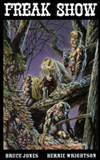 01. Freak Show
01. Freak Show
I struggled between the placement of my top two. It was a war between sentimentality and technical brilliance.
As far as I know, this story first appeared in Heavy Metal over six months in 1982. It was in color and was influential even then. But it was out of place for a magazine devoted mostly to sci-fi and fantasy.
There aren't any comics in this world more grotesque or perfect in execution than the collected edition of Freak Show. Desperado / Image published a nice signed and limited hardcover and softcover in 2005. The best hardcover I have ever bought.
The story follows a man whose compassion is the only thing keeping various freaks from suicide as he travels the countryside collecting oddities for his show. A beautiful woman stumbles onto the campground and believes herself besieged by demons until she is shown the error of her ways and lives with the traveling show. The man takes her as his mate and eventually she bares a child. When the man discovers the freakish offspring he loses his mind and, believing his wife to have been unfaithful, kills them all. And that is just the set-up.
This tightly woven tale of revenge and penance is an homage to Tod Browning's controversial film, Freaks (at least in Bernie Wrightson's case, as Bruce Jones claims to have never seen the film). The story is perfect and is really a template for a good horror story. The art is masterful. The original printing, of which I only have part three, looks amazing in color, but the story is truly serviced in the black and white reprint with the darkened lines and creepier atmosphere.
That's it. According to me it doesn't get any better than that. Buy a copy, hell buy two so that the next time someone says to you that horror comics don't work, you have something to smack them across the face with.
Thank you for abiding my trip down a lifetime of horror comics and Happy Halloween.

